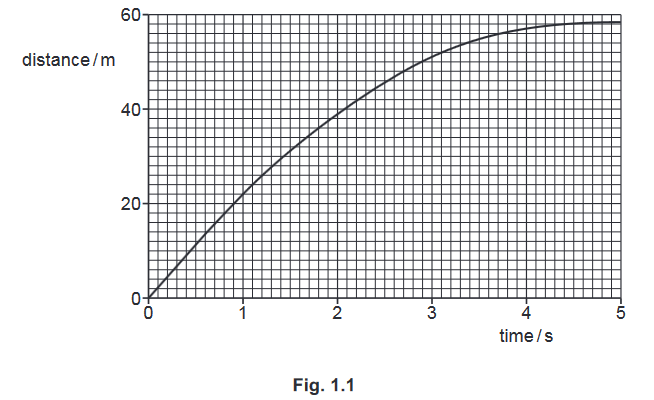Question:
A car of mass m is travelling along a straight, horizontal road at a constant speed v.
At time t = 0, the driver of the car sees an obstruction in the road ahead of the car and applies the brakes.
The car does not begin to decelerate at t = 0.
(a) Explain what is meant by deceleration.
Answer/Explanation
Ans: negative acceleration or decrease in velocity
change in velocity per unit time or rate of change of velocity
(b) Suggest one reason why the car does not begin to decelerate at t = 0.
Answer/Explanation
Ans: delay in applying brakes or (human) reaction time or foot not removed from accelerator
(c) Fig. 1.1 is the distance–time graph for the car from t = 0.

(i) State the property of a distance–time graph that corresponds to speed.
Answer/Explanation
Ans: gradient or slope
(ii) Using Fig. 1.1, determine the initial speed v of the car.
v = …………………………………………………
Answer/Explanation
Ans: 20.5 m / s ⩽ answer ⩽ 23.5 m / s
the coordinates at one point on curve (e.g. (0.50, 11))
and (upper) time coordinate ⩽ 1.0 s
(d) When the car is decelerating, there is a constant resistive force F on the car due to the brakes.
The deceleration of the car is greater than F/m and is not constant.
Explain why:
(i) the deceleration of the car is greater than F/m.
Answer/Explanation
Ans: air resistance / air friction acts on the car
(ii) the deceleration is not constant.
Answer/Explanation
Ans: air resistance / resultant / resistive force decreases
and as speed decreases / car decelerates
air resistance / resultant / resistive force decreases / changes
Question
A train is passing through a station at constant speed, as shown in Fig. 3.1. The track is horizontal.

The engine produces a forward thrust of 70 000 N. There is a 25 000 N force opposing the
motion, due to friction in the wheels.
(a) Mark these forces on Fig. 3.1, using an arrow labelled 70 000 N and an arrow labelled 25 000 N. [2]
(b) The train is travelling at constant speed, so there must be another horizontal force acting on it.
(i) State the direction of this force.
………………………………………………………………………………………………………………….
(b) Calculate the size of this force.
size of force =………………………………………….. N
(iii) Suggest what might be causing this force.
………………………………………………………………………………………………………………….[3]
(c) Once the train has passed the station, the driver increases the engine’s forward thrust.
All other forces stay the same.
(i) What happens to the train? …………………………………………………………………………..
(ii) Why does this happen? ………………………………………………………………………………..
………………………………………………………………………………………………………………….
………………………………………………………………………………………………………………….[2][Total: 7]
Answer/Explanation
Ans: (a) 70 000(N) arrow to right accept labelled “thrust” 25 000(N) arrow to left accept labelled “friction”
(b) (i) to left OR backward OR opposing motion
(ii) 45 000(N)
(iii) air friction/air resistance/drag NOT wind/wheels/weight NOT if any incorrect extra e.g. weight
(c) (i) accelerates OR speed increases OR moves faster
(ii) idea of unbalanced force e.g. forward force > backward force NOT just forward force is bigger
